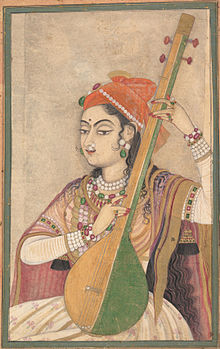Kafi
| Music of Pakistan | |
|---|---|
 |
|
| Genres | |
| Specific forms | |
| Religious music | |
| Traditional music | |
| Media and performance | |
| Music awards |
Lux Style Awards Hum Awards Pakistan Media Awards |
| Music festivals |
All Pakistan Music Conference Lahore Music Meet |
| Music media | |
| Nationalistic and patriotic songs | |
| National anthem | Qaumi Taranah |
| Regional music | |
| Local forms | |
| Related areas | |
| Music of India | |
|---|---|

A Lady Playing the Tanpura, ca. 1735 (Rajasthan)
|
|
| Genres | |
|
|
| Media and performance | |
| Music awards | |
| Music festivals | |
| Music media | |
| Nationalistic and patriotic songs | |
| National anthem | Jana Gana Mana |
| Regional music | |
|
|
Kafi (Punjabi: ਕਾਫ਼ੀ (Gurmukhi), کافی (Shahmukhi), Hindi: काफ़ी), Sindhi:ڪافي) is a classical form of Sufi poetry, mostly in Punjabi and Sindhi languages and originating from the Punjab and Sindh regions of South Asia. Some well-known Kafi poets are Baba Farid, Bulleh Shah, Shah Hussain, Shah Abdul Latif Bhittai, Sachal Sarmast and Khwaja Ghulam Farid. This poetry style has also lent itself to the Kafi genre of singing, popular throughout South Asia, especially Pakistan, Bangladesh and India. Over the years, both Kafi poetry and its rendition have experienced rapid growth phases as various poets and vocalists added their own influences to the form, creating a rich and varied poetic form, yet through it all it remained centered on the dialogue between the Soul and the Creator, symbolized by the murid (disciple) and his Murshid (Master), and often by lover and his Beloved.
The word Kafi is derived from the Arabic kafa meaning group. The genre is said to be derived from the Arabic poetry genre, qasidah, a monorhyme ode that is always meant to be sung, using one or two lines as a refrain that is repeated to create a mood. Kafi poetry is usually themed around heroic and great romantic tales from the folkfore, often used as a metaphor for mystical truths, and spiritual longing.
...
Wikipedia
